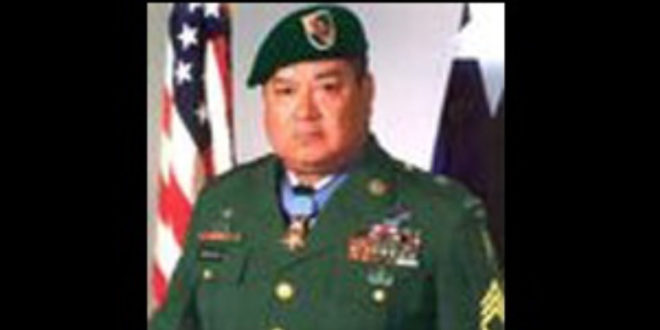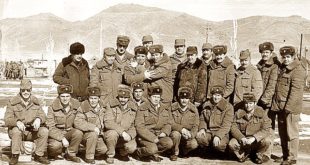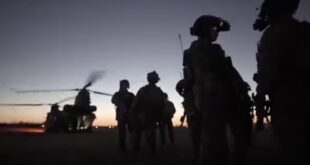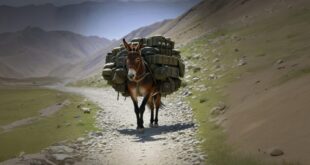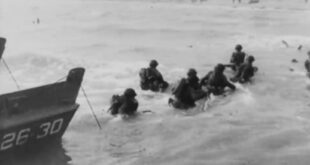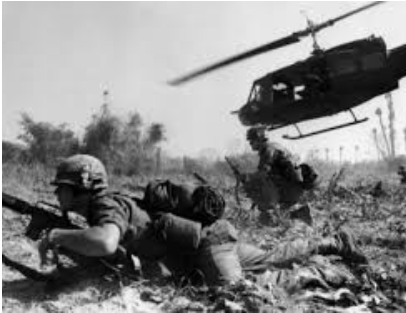
By Eric Blehm
In LEGEND, bestselling author Eric Blehm takes as his canvas Southeast Asia, and tells the unforgettable account of the U.S. Army’s 240th Assault Helicopter Company and Green Beret (Studies and Operations Group) Staff Sergeant Roy Benavidez, who risked everything to rescue a Special Forces team trapped in the Fishhook area of Cambodia, 1968.
Soldier of Fortune learned about this book, and the lengths to which Blehm went in his research to get this story right, spending nearly two years interviewing dozens of eyewitnesses to the events portrayed and digging up boxes full of archives and official documents regarding this particular mission, period, and the quest for a long overdue Medal of Honor.
It’s a no BS journalistic account endorsed by many in the special operations community, including a legend in his own right, Major General John K. “Jack” Singlaub, U.S. Army (Ret.), whose statement on the back cover of the book reads: “I fought beside and led U.S. Special Operations soldiers, sailors, and airmen during three wars – WWII, Korea, and Vietnam – including the men [of SOG] depicted in LEGEND. Never have I read a more powerfully honest, realistic or moving account of the war in Southeast Asia. Eric Blehm masterfully encapsulates the hearts of the men, their impossible mission, and the quagmire of politics of the era and wraps it up in a single bloody battle that portrays the American fighting man at his best.”
That’s good enough for us, so without further introduction, let the following excerpted material from LEGEND whet your appetite for a book worthy of our “keeper” bookshelf. It’s one hell of a wild ride through one soldier’s life, and the battle that indeed made him a legend.
— SOF
This story begins in a U.S. government–issued body bag. The date was May 2, 1968; the location, Loc Ninh Special Forces camp near the Cambodian border in South Vietnam. Inside the zippered tomb lay a stocky, five-foot-six-inch U.S. Army Green Beret staff sergeant named Roy Benavidez. Earlier that day he had jumped from a hovering helicopter, then run through withering enemy gunfire to reach what remained of an American-led 12-man Special Forces team surrounded by hundreds of North Vietnamese Army soldiers. A few strides into his heroic dash, a bullet passed through his leg and knocked him off his feet. Determined to reach his comrades, he rose and continued his sprint, zigzagging through enemy fire for almost 75 yards before he went down again, this time from the explosion of a near-miss shoulder-fired anti-tank rocket. Ignoring both the bullet and shrapnel wounds, he crawled the remaining few yards into the beleaguered team’s perimeter, took control, provided medical aid, and positioned the remaining men to fight back the endless waves of attacking NVA while he called in dangerously close air support.
For the next several hours, Benavidez saved the lives of eight men during fierce, at times hand-to-hand, combat before allowing himself to be the last man pulled into a helicopter that had finally made it to the ground amid the relentless onslaught. There he collapsed motionless, atop a pile of wounded and dying men. His body—a torn-up canvas of bullet holes, shrapnel wounds, bayonet lacerations, punctures, burns, and bruises—painted a bloody portrait of his valor that day.
For nearly a decade his story, and the story of the May 2 battle, remained untold. That was until Fred Barbee, a newspaper publisher from Benavidez’ hometown of El Campo, Texas, got wind of it and ran a cover story in the El Campo Leader-News on February 22, 1978. The intent of his article was twofold: to honor Benavidez by recounting his heroics and to berate the Senior Army Decorations Board for its staunch refusal to bestow upon Benavidez what Barbee believed was a long-overdue and unfairly denied Medal of Honor.
Barbee wanted to know what the holdup was. His tireless research elicited few answers from the Decorations Board, whose anonymous members, he quickly learned, answered to no one—not congressional representatives, not colonels (two of whom had lobbied for Sergeant Benavidez), and certainly not a small-town newspaper publisher.
But Barbee wouldn’t let it go. He was perplexed when the board cited “no new evidence” as its most recent reason for denying the medal, when in fact there was plenty of new evidence. Topping the list was an updated statement written by Benavidez’ commanding officer, citing previously unknown facts that corroborated the sergeant’s legendary actions. There was also testimony from the helicopter pilots and air crews who witnessed the battle from the air or listened in on the radio as events transpired. According to the board, although these accounts were compelling, there was no eyewitness testimony from anybody on the ground. This criterion seemed impossible to meet; almost nobody on the ground May 2 had survived either that day or the war. The few who had were off the grid, having either become expatriates or burned their uniforms and melted into an American populace that more often than not had shamed them for their service in Vietnam.
“What, then, happened on that awful day . . . in the Republic of Vietnam?” Barbee questioned in his article. “Or, perhaps this particular action on May 2, 1968, actually took place outside the boundaries of Vietnam, perhaps in an area where U.S. forces were not supposed to be, perhaps that is the reason for the continuing runaround. . . ”
The Associated Press picked up Barbee’s article, and it circulated into the American news sections of some international papers. By July 1980, it had traveled halfway around the world to the South Pacific, finding its way into the hands of a retired Green Beret and Vietnam veteran who was living in Fiji with his wife and two young children.
Brian O’Connor immediately recognized the date in the article—May 2, 1968; the hours-long battle was his worst, most horrific memory from what was known as “the secret war.” He remembered being under a pile of bodies on a helicopter, slippery with blood and suffocating. Now, as he read the story, O’Connor was appalled to learn that Benavidez had never received the Medal of Honor. He knew he would have to revisit and recount his memory of the battle—in detail. He owed it to the man who had, against all odds, saved his life.
Determined to set the record straight, O’Connor dated a sheet of paper July 24, 1980, and addressed it to the Army Decorations Board:
“This statement,” O’Connor wrote, “on the events that happened on 2 May 1968, is given as evidence to assist the decision made on awarding the Congressional Medal of Honor to Master Sergeant Roy Benavidez. Because of the classified nature of the mission, some important details will be left out which should not in any way affect the outcome of the award.”
Page after page, the darkness flowed from his pen as O’Connor re-lived the nightmarish day. From the insertion of his 12-man team deep behind enemy lines to the moment his South Vietnamese point man—Bao just a few yards ahead of him—stepped out of the jungle to cross a clearing just as an enemy NVA squad, or hunter-killer team, emerged from the jungle across the same clearing, coming straight toward them.
The two teams faced each other in the clearing. Then Bao moved confidently ahead and began talking loudly to the NVA squad leader.
 Looking down at his boots to hide his face, O’Connor casually pulled a piece of paper out of his pocket. He continued to stare at it while walking a few steps backward to stand beside his assistant team leader (ATL), Lloyd Mousseau. The two men kept their heads down, studying the paper as if it were a map.
Looking down at his boots to hide his face, O’Connor casually pulled a piece of paper out of his pocket. He continued to stare at it while walking a few steps backward to stand beside his assistant team leader (ATL), Lloyd Mousseau. The two men kept their heads down, studying the paper as if it were a map.
Their interpreter, Tuan came up beside them. “They think we’re from the other unit,” he whispered.
“Tell them we’re looking for a chopper that was shot at, that we heard go down,” Mousseau whispered back. Tuan nodded, but before he could move ahead and deliver the message, Bao turned around and commanded the team to search the thickest jungle area, as if he was in charge.
Mousseau and O’Connor immediately obeyed, but as they headed toward the clearing’s edge, Mousseau quietly said to O’Connor, “I think they might have seen your face. When Bao is clear, you take the left and I’ll take the right, but only if things look bad.”
Bao continued to bark orders, and the NVA leader waved what appeared to be a parting “good-bye.” Suddenly, the enemy officer called out harshly to Bao.
“They know!” shouted Tuan.
What happened next was instantaneous as Mousseau, O’Connor, and Bao went on autopilot: Mousseau targeted the enemy soldiers to the right, O’Connor took those on the left, and Bao, not privy to the impromptu plan, joined them in sending a hail of bullets into any still standing. Their marksmanship under pressure was astounding: all but two of the 12 NVA were dead within seconds. The two survivors dropped to their knees and returned fire. One let loose a shoulder-fired anti-tank rocket that passed over the team’s head and exploded in the trees.
Mousseau, O’Connor, and Bao continued to fire while back-stepping into the jungle, where the rest of the team remained concealed and the team leader (TL) Leroy Wright was calling for immediate extraction. Once the three men were clear, their Civilian irregular Defense Group (CIDG) teammates opened fire and killed the two remaining NVA.
O’Connor continued to recount the declining situation in his statement a decade later, the heroism of his buddies, the attempt to evade the enemy, the bloody battle to secure a pathetic perimeter while waiting for air support. These were the desperate hours when they were surrounded and vastly outnumbered by what many estimated was a battalion or more of well-armed North Vietnamese Army soldiers. He pieced together the torn and sometimes blurry snapshots from his memory, re-counting the deaths of his teammates one by one, as well as the several helicopter rescue attempts beaten back by a determined enemy that was on the verge of overrunning their position:
“The interpreter, who now had his arm hanging on his shoulder by a hunk of muscle and skin, tugged at me to say the ATL wanted me,” O’Connor wrote in his statement. “Firing and rolling on my side, I saw the ATL on his emergency radio and I nodded my head and the ATL hollered to me “ammo—ammo— grenades.
“Stripping the two dead CIDG of their ammo and grenades, I moved a meter or two, where I threw the clips and grenades to a CIDG, who in turn threw them to the ATL. During the minute or two of calm, the interpreter and I patched our wounds, injected morphine syrettes, tied off his arm with a tourniquet, and ran an IV of serum of albumin in my arm for blood loss . . . while the one remaining CIDG observed for enemy movement. I looked over to the ATL, and they were doing about the same thing. . .
“We had another few seconds of silence and the ATL shouted, ‘They’re coming in.’ I figured a final assault to overrun us and we prepared for the worst. . . I caught a burst of auto fire in the abdomen and the radio was shot out. I was put out of commission and just laid behind [a] body firing at the NVA in the open field until the ammo ran out. . . I was ready to die.”
The platoon sergeant for the 240th Assault Helicopter Company Mad Dogs (helicopter gunships), Sergeant First Class Pete Jones, was so “short” he could almost taste the cold beer he planned to order on his freedom bird home in two weeks. But his crew chiefs had been flying so much the previous week, he’d decided to give one of them a break by volunteering for the mission, aboard Mad Dog One. Now the gunship was bucking through the air, and he was peppered by fragments of bullets as they ripped through the floor and bounced around the cabin. His gunner—a guy everybody called Swisher because his fake front teeth made a swishing sound when he talked—was blown off his M60 and lay motionless on his back, his eyes closed.
Jones looked for a wound, then found it: a bullet had hit the edge of Swisher’s helmet and entered his forehead, leaving a tiny hole from which blood oozed. The impact had cracked the helmet from front to back. Jones barely had time to register that Swisher was dead before he smelled the burning oil, saw the smoke, and heard the change in the tone of the engine. The helicopter banked away from the pickup zone (PZ), leveled off over the trees, and began to gain altitude as it accelerated west.
An instant later, 240th Greyhound (Huey “slick”) pilot, Roger Waggie flew Greyhound Three into the same wall of anti-aircraft fire. He could hear the bullets coming up around his feet, distinct thuds and pings that penetrated the Plexiglas nose bubble, ripped through the thin metal skin of the aircraft, and impacted with the underside of their armored seats.
Leaning over their M60s, the gunners returned fire into the jungle, but the deep, stuttering roar from Michael Craig’s gun stopped abruptly as a bullet cleared the underside of his “chicken plate” (ballistic armor worn by air crews) and tore into his ribs and chest. The impact from the round flung him up and backward onto the cabin floor. “Your crew chief is hit!” yelled the Special Forces bellyman on board to assist with the extraction. He reached over to help Craig just as the other door gunner was spun backward by a bullet to the shoulder.
Copilot Hoffman instinctively gripped the controls and yelled, “Breaking right!” as Waggie radioed Armstrong, who was hot on their tail in Greyhound Four and about to fly into a wall of fire. “Bank right, Greyhound Four, bank right! We’re taking hits! Abort extraction! Abort extraction!”
O’Connor thought it sounded as if the slicks “had the whole jungle firing at them,” yet the area surrounding the team remained silent. Suddenly Greyhound Four raced into view over their left shoulders, skimming the treetops from the northeast. Its nose flared upward to arrest its speed and the slick dropped into the clearing, whipping and flattening the grass below in the hurricane created by the rotor wash. The helicopter hovered there momentarily about 100 yards away from the team.
There was no time for Wright to signal Armstrong—smoke or mirror—because a half-dozen NVA immediately emerged from the trees adjacent to the helicopter. They approached Greyhound Four, waving. The slick’s skids tapped the ground, then settled into the grass, ready for the team to board.
My God, thought O’Connor, they think that’s us! At the same moment, the team’s CIDG came to the same realization and fired on the NVA that were nearing the helicopter. From within Greyhound Four, Specialist 4 Robert Wessel, the right-side door gunner, identified the CIDG’s fully automatic gunfire as enemy fire and strafed the American team’s position.
“Cease fire!” Wright yelled at the CIDG. The guns fell silent, and Wright shouted into his radio, “Get that chopper back in the air!” There was no response, and he switched channels, attempting to reach the forward air controller, Air Force Captain Robin Tornow, the C&C slick, the extraction pilot across the clearing—anybody who could get the message that Greyhound Four was about to be ambushed by the NVA: “Get that chopper back in the air! Get them out of there! That is Charlie, I repeat . . .”
Mad Dog One, mortally wounded and hemorrhaging—oil, hydraulic fluid, and fuel spraying out over the jungle—continued flying west, farther into Cambodia. The pilot, William Curry, fought the gunship’s controls to gain altitude and mileage, willing it into a bank that would bring the helicopter back on an eastward bearing. At the same time he scanned the ground below for a place to set down. There was the Ho Chi Minh Trail with its stream of enemy trucks, the PZ he’d just been shot out of, and the green of the jungle. So much green.
Alone in the backseat with the dead gunner, Swisher, Jones gripped his M60, acutely aware of the unnatural sounds of the laboring aircraft. He kept glancing down at Swisher on the floor—his closed eyes, the speck of blood in the middle of his forehead, and that perfect vertical crack down the center of his helmet. Out the window, the horizon receded while the gunship shook, rattled, and fought to gain altitude—200 feet, 300, 400; from hell to purgatory they climbed. They were no longer taking fire, but this was dangerous air, low enough to be reached by enemy small-arms ground fire and high enough to be spotted and tracked by anybody looking up.
Then there was a very distinct quiet of an engine suddenly stopping. “Hang on,” Curry said calmly over the intercom. “We’re going down.”
A couple thousand feet overhead, Tornow could hear the incredible volume of gunfire over the radio and knew the situation on the ground was dire. Then he heard the report that Mad Dog One had gone down somewhere to the east.
Taking his Bird Dog Cessna into a shallow dive for a closer look, Tornow was dismayed by the number of NVA converging on the team’s position. Everywhere he looked, there were green uniforms, around 250 NVA visible in the PZ. It was impossible to tell how many were in the surrounding jungle, but it was obvious that this was not just a patrol: this was an enemy base camp.
Taking a deep breath, Tornow took quick stock of the facts. Mousseau had managed to report that two of the original 12 team members were dead and three were seriously wounded. That left seven men against all those he could see—and likely double or triple that number were concealed in the jungle. Enemy vehicles were arriving on all visible roads to bolster the siege.
The first extraction attempt had narrowly escaped disaster, with two slicks limping back to base and six of the eight crewmen critically wounded. One gunship had been shot down and was in enemy-occupied territory. The other was too shot up to fly. It was as bad as Tornow had ever seen it for a team, probably “as bad as it gets,” he later told a friend.
“In an impulsive reaction,” Tornow proceeded to risk his career by breaking the explicit rules of engagement. “I turned my radio to the international emergency frequency and called, ‘Mayday, Mayday, Mayday. Any fighters in the area, I need anything I can get. Vector 10 miles southwest of Loc Ninh. I need to put you in immediately. Troops in heavy contact. This is a Daniel Boone tactical emergency.’”
This “Daniel Boone tactical emergency” or “TAC-E” was a coded distress call that cut in on all radio frequencies across Vietnam. It meant that a team was about to be overrun, and it summoned all available aircraft to converge immediately, especially “fast movers” such as jet fighters and tactical bombers—which were forbidden to cross into Cambodia, even in support of teams that were in heavy or overwhelming contact. What Tornow had just requested in order to save the team had all the makings of an international border incident, and maybe even a court-martial.
“I repeat,” Tornow continued to call out over the radio, “this is a Daniel Boone tactical emergency.”
USNS Benavidez Honors Army Medal of Honor Hero
By Gerry J. Gilmore DOD
WASHINGTON, Sept. 19, 2000 – The late Roy P. Benavidez, who received the Medal of Honor in 1981 for valor in Vietnam, is the latest soldier whose name will be borne on a Navy ship.
|
Navy Secretary Richard Danzig announced Sept. 15 that the next in a series of re-supply ships will be named the USNS Benavidez. The retired Army master sergeant died at age 63 on Nov. 29, 1998, in San Antonio. He was buried with full military honors at Fort Sam Houston National Cemetery in San Antonio.
“Our Bob Hope-class of ships are resolute assets that are always quietly there in the background,” Danzig said in his announcement. “They are capable of coming forward in a vital way when America calls for reinforcement of its combat needs around the world. Roy Benavidez personified that same spirit throughout this life, and most powerfully during a single action that saved lives in combat.
The Benavidez is scheduled to be launched next summer. It is the seventh in a class of 950-foot-long roll-on/roll-off sealift ships. The diesel-powered ships are 106 feet abeam, displace about 62,000 long tons and can sail at a sustained 24 knots.
Born in Lindenau, Texas, on Aug. 5, 1935, Benavidez would later join the Army to become a Special Forces soldier. Of Mexican and Yaqui Indian ancestry, he later co-authored the autobiographical “Medal of Honor – A Vietnam Warrior’s Story.”
“Roy was a soldier to be emulated by those wearing the uniform and an example of a self-made person. He was a role model to many young Hispanics and made a lot of public appearances at schools,” said retired Army Master Sgt. Charlie Hoffman, who had commented about his friend at the time of his death.
Benavidez’s destiny took him to Vietnam, where, as a member of Detachment B56, 5th Special Forces Group (Airborne), 1st Special Forces, he challenged death on May 2, 1968.
A staff sergeant at the time, Benavidez “distinguished himself conspicuously by gallantry and intrepidity at the risk of his life above and beyond the call of duty,” his Medal of Honor citation states. The citation credits him with helping to save the lives of eight of his Special Forces comrades during helicopter evacuations during a firefight with North Vietnamese regular forces west of Loc Ninh.
Benavidez suffered a broken jaw and 37 bullet and bayonet puncture wounds in the fight. He was so mauled that his commanding officer thought he wouldn’t live long enough to receive a Medal of Honor. He nominated Benavidez for the Distinguished Service Cross instead, because the No. 2 award would take less time and paperwork to obtain.
Benavidez, however, survived his wounds and received the DSC from Gen. William C. Westmoreland. Only years later did the general learn detailed particulars of Benavidez’s heroism. The DSC was upgraded to a Medal of Honor, and Benavidez received the award in 1981 from President Ronald Reagan in a White House ceremony.
“Master Sgt. Roy Benavidez was a true American hero, rising from humble origins in South Texas to become an Army legend,” said Army Secretary Louis Caldera. “The Navy’s recognition of his selfless service is truly an appropriate tribute to Master Sgt. Benavidez’s memory, and to the ideals of our nation that he epitomized.”
Benavidez is one of the 37 Hispanic Americans among the 3,400 recipients of the Medal of Honor since the award was created in 1861.
CITATION
M/Sgt. (then S/Sgt.) Roy P. Benavidez, United States Army, who distinguished himself by a series of daring and extremely valorous actions on 2 May 1968 while assigned to Detachment B-56, 5th Special Forces Group (Airborne), 1st Special Forces, Republic of Vietnam. On the morning of 2 May 1968, a 12-man Special Forces Reconnaissance Team was inserted by helicopters in a dense jungle area west of Loc Ninh, Vietnam, to gather intelligence information about confirmed large-scale enemy activity. This area was controlled and routinely patrolled by the North Vietnamese Army. After a short period of time on the ground, the team met heavy enemy resistance, and requested emergency extraction. Three helicopters attempted extraction, but were unable to land due to intense enemy small-arms and anti-aircraft fire. Sgt. Benavidez was at the Forward Operating Base in Loc Ninh monitoring the operation by radio when these helicopters returned to off-load wounded crewmembers and to assess aircraft damage. Sgt. Benevidez voluntarily boarded a returning aircraft to assist in another extraction attempt. Realizing that all the team members were either dead or wounded and unable to move to the pickup zone, he directed the aircraft to a nearby clearing while he jumped from the hovering helicopter, and ran approximately 75 meters under withering small-arms fire to the crippled team. Prior to reaching the team’s position he was wounded in his right leg, face, and head. Despite these painful injuries, he took charge, repositioning the team members and directing their fire to facilitate the landing of the extraction aircraft and the loading of the wounded and dead team members. He then threw smoke canisters to direct the aircraft to the team’s position. Despite his severe wounds and under intense enemy fire, he carried and dragged half of the wounded team members to the awaiting aircraft. He then provided protective fire by running alongside the aircraft as it moved to pick up the remaining team members. As the enemy’s fire intensified, he hurried to recover the body and classified documents on the dead team leader. When he reached the leader’s body, Sgt. Benevidez was severely wounded by small-arms fire in the abdomen and grenade fragments in his back. At nearly the same moment, the aircraft pilot was mortally wounded, and his helicopter crashed. Although in extremely critical condition due to his multiple wounds, Sgt. Benevidez secured the classified documents and made his way back to the wreckage, where he aided the wounded out of the overturned aircraft, and gathered the stunned survivors into a defensive perimeter. Under increasing enemy automatic-weapons and grenade fire, he moved around the perimeter distributing water and ammunition to his weary men, reinstilling in them a will to live and fight. Facing a buildup of enemy opposition with a beleaguered team, Sgt. Benevidez mustered his strength, began calling in tactical air strikes and directed the fire from supporting gunships to suppress the enemy’s fire and so permitted another extraction attempt. He was wounded again in his thigh by small-arms fire while administering first aid to a wounded team member just before another extraction helicopter was able to land. His indomitable spirit kept him going as he began to ferry his comrades to the craft. On his second trip with the wounded, he was clubbed from additional wounds to his head and arms before killing his adversary. He then continued under devastating fire to carry the wounded to the helicopter. Upon reaching the aircraft, he spotted and killed two enemy soldiers who were rushing the craft from an angle that prevented the aircraft door-gunner from firing upon them. With little strength remaining, he made one last trip to the perimeter to ensure that all classified material had been collected or destroyed and to bring in the remaining wounded. Only then, in extremely serious condition from numerous wounds and loss of blood, did he allow himself to be pulled into the extraction aircraft. Sgt. Benevidez’ gallant choice to join voluntarily his comrades who were in critical straits, to expose himself constantly to withering enemy fire, and his refusal to be stopped despite numerous severe wounds, saved the lives of at least eight men. His fearless personal leadership, tenacious devotion to duty, and extremely valorous actions in the face of overwhelming odds were in keeping with the highest traditions of the military service and reflect the utmost credit on him and the United States Army.
 Soldier of Fortune Magazine The Journal of Professional Adventurers
Soldier of Fortune Magazine The Journal of Professional Adventurers


